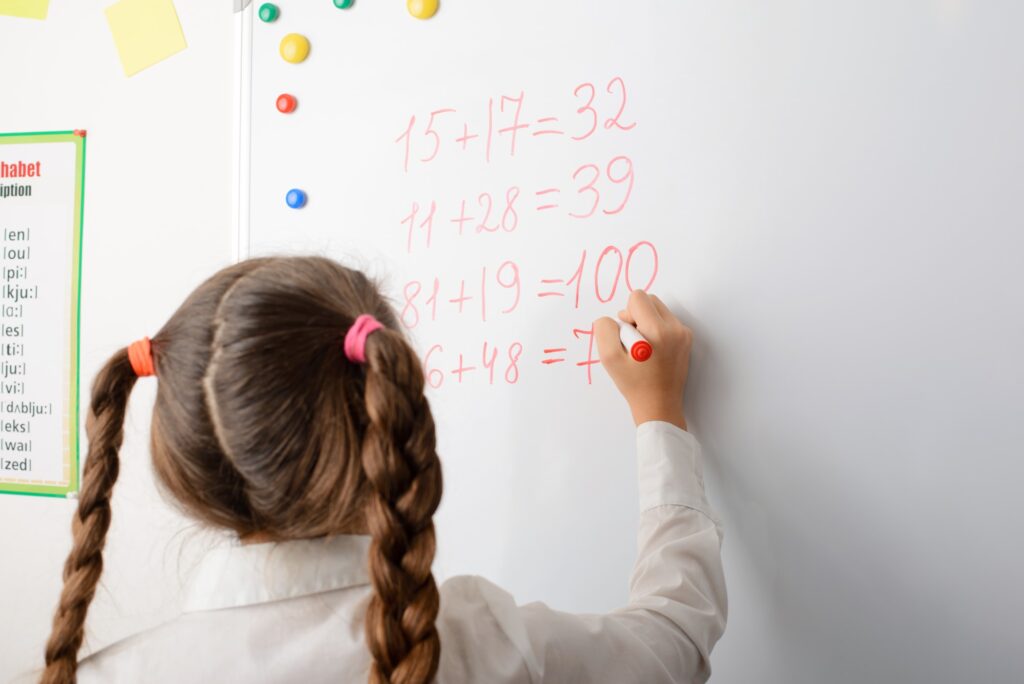“Oh, look, there’s a special offer on the brand of canned tuna that we usually buy!” remarked May, as she walked through the supermarket aisle. “€2.49 for a pack of three cans. Sounds like a good deal!”
“Hmm… I’m not too sure.” Alan, her brother, was inspecting one of the cans.
“Yeah, they don’t expire quickly,” he admitted. “And there are usually priced at 89 cents each, so they are supposed to cost… let’s see…”
“€2 and, uh, 67 cents, Uncle Alan!” cried Janet, who was listening intently.
May, her mother, was astonished.
“Wow, sweetie! How did you figure that out so quickly?”
“Easy, Mum. Nine times three is 27, then you put a zero at the end, then you subtract three.”
The mother’s face did not hide her bewilderment. “What?”
“Look, Mum, if they were priced at 90 cents each, then three cans would cost 270 cents, right? But they’re each priced one cent less. So I subtracted three cents off the 270…”
“Oooh, that’s very clever, Janet! I’m impressed!” acknowledged the mother.
“Indeed, Janet”, added her uncle. “You’re very good at this!”
“That’s what we are learning at school. Mental maths. I like it!” the girl enthused.
“So, let’s see, the deal will save us… 18 cents. That’s a good deal,” Alan observed.
Eventually, our three protagonists went to the cashier to pay for their things. May reached for her purse.
“Oh, shoot! I forgot my card at home. I only have €50 and a few coins. That’s fine though; it should be enough to pay for these things.”
“You think so, May?” Alan said. “I’d say this stuff costs around €65 in total. Look, I’ll pay with my card, don’t worry, then you pay me when we arrive home, okay?”
It turned out that both were wrong. “That would be €77.45, madam,” the cashier said.
Alan pondered – that total was quite a bit more than he thought it would be. He wondered where he went wrong in his estimate. But he didn’t say anything. He duly paid with his card and helped his sister to pack their things in her car.
When they arrived home, Alan and his niece Janet helped May store their things in the pantry and freezer. May was marking each item they bought on the receipt. Then she suddenly frowned.
“Looks like we need to get back to the store. The cashier made a mistake – he scanned the meat twice. He overcharged us by €10.91. Look!” as she showed her brother the receipt.
“I knew it!” Alan cried. “I told you that our things should have roughly cost €65!”
“How did you know, Uncle Alan?” Janet asked.
“Well, I was secretly adding up the total in my head – roughly – as we were putting each item in our trolley,” her uncle said with a grin.
“Looks like Janet got her maths skills from her uncle!” May said with a laugh.
Did you notice, from this story, how doing arithmetic in our heads can often help us in our daily lives? How many times did somebody in the story use mental arithmetic?
Alexander Farrugia is a senior lecturer at the Department of Mathematics, University of Malta, Junior College.

Curious facts
- People often think that doing maths is the act of adding, subtracting, multiplying and dividing numbers. But this is just a small part of mathematics, called arithmetic. Mathematics is a way bigger subject than arithmetic! Mathematics involves reasoning about things that can be properly defined, and then proving properties about them. That makes maths very useful indeed!
- To multiply a number by five, it is instead often easier to half the number, then append a zero at the end of the answer or shift the decimal point by one place to the right. For example, to work out 26 times five in our heads, we can half 26, to get 13, then append a zero to get 130. To work out 37 times five, half 37 to get 18.5, then shift the decimal point; so 37 times five is 185.
- A number is divisible by four if the number made up of its last two digits is divisible by four. Sometimes, however, this doesn’t help us; for example, is 92 divisible by four? For such cases, we can resort to the following rule. A two-digit number is divisible by four if twice its first digit plus its second digit is divisible by four. For example, 92 is indeed divisible by four, because twice nine plus two is 20, which is divisible by four!
- The numbers we use nowadays, as well as their arithmetic rules, comprise what is called the Hindu-Arabic system. Its use spread to the Western world in the 13th century mainly thanks to Italian mathematician Fibonacci. In his book Liber Abaci, he remarks that: “The method of the Indians surpasses any known method to compute. It’s a marvellous method! They do their computations using nine figures and the symbol zero”.










